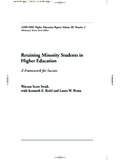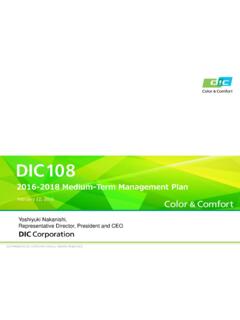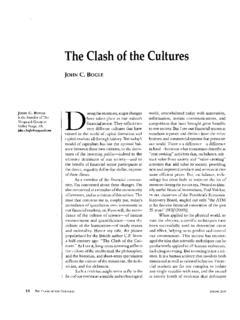Transcription of A publication of the Educational Policy Institute ...
1 publication of the Educational Policy InstituteJanuary 2006In This : seven guiding Questions for Student Retention by Dr. Watson ScottSwailby Watson Scott Swail, students in school seemsharder than it should be. Today sstudents appear to be less pre-pared, have more emotional baggage,and have a different set of expectationsthan prior cohorts. It s arguable whetherany or all of this is true, but for the aver-age campus professional, it seems ability to keep students in schoolis an important daily task on our cam-puses. Losing students , from aneconomic standpoint, is just bad busi-ness. Every student lost represents afinancial loss for institutions.
2 Institutionsmiss out on tuition and fees from thatstudent, income from books and ser-vices, housing, and other revenuestreams. In the long term, institutions,especially four-year undergraduate insti-tutions, miss out on revenue from alumnicontributions, which account for billionsof dollars a year course, losses due to student attri-tion aren t just realized on theinstitutional side. students lose too. Stu-dents who dropout of the educationalpipeline lose their initial fiscal invest-ment and those who leave beforecompletion of their program are morelikely to hold significant debt loan andbe less likely to repay those loans.
3 Thus,they are prone to loan default. But per-haps the most important thing studentslose is time. students who leave schooloften lose valuable life time; timespent where little is gained. We under-stand that education has an opportunitycost to it, but we often forget that thecost is only repaid to those who com-plete their studies, not those who , there is significant motivationfor institutions and students to stay thecourse. Unfortunately, only half of fresh-man students who initiate their studiesat a four-year institution leave with a BAin hand. The percentage at two-year in-stitutions is far less.
4 Not exactlyuplifting, but that s path to increasing student reten-tion on campus is long and hard. To helpyou get your mind around the task aheadof you, here are seven questions that youneed to you understand the nature ofthe problem? This isn t as dumbas it sounds. The retention and persis-tence of students is a very complex knowing your cohort graduationrate isn t good enough. You need to getat the heart of the problem through care-ful analysis of your entire studentpopulation. Work with your institutionalresearch department to disaggregate theretention and persistence data of vari- seven guiding Questions for Student RetentionINTERVIEW: George Kuh and the National Survey of Student Engagement (NSSE)THE REVIEW: Student Success looks at a new book edited by Alan Seidman titledCollege Student PRACTICE: The Access for Success Program (College of the North Atlantic,St.)
5 John, Newfoundland)ous populations on campus, includingstudents of color, Pell-eligible students , students from certain geographic areas,resident vs. commuter students , et remember that it isn t only aboutpersistence-to-degree rates. What do youknow about the transfer process at yourinstitution? Why are students transfer-ring, and where is it they aretransferring?Do you know why your studentsleave? Ultimately, you need toknow why students leave. There s anentire body of literature about this topic,but ultimately you need to know whyyour students leave, not someone in an average institution in an average state.
6 Exit interviews are your friend (sayit over and over again and you ll start tobelieve it. Really). These are extraordi-narily important opportunities to captureinformation on why your students leave,and what role your institution plays inthe departure process. Once you ve col-lected and analyzed this information,47911210 AWARD ANNOUNCEMENTS: EPI Announces Best Practice Award in StudentRetention and Outstanding Service Award. Nominations Open SuccessJanuary 2006end of this article and visiting ourwebsite ( ).Do you have evidence that thereexists significant support on cam-pus to do something about this issue?
7 The one thing I ve learned over the yearsis that institutional change only happenswhen faculty and leadership are support-ive of the change. Both camps mustrealize that retention is an important is-sue, regardless of whether policymakersmandate performance measures. Facultymembers are the closest to students , sothey automatically become the key com-ponent of a retention program. Anychange that takes place at the classroomlevel must involve faculty. At the otherend, leadership must provide solid, un-wavering support for the retentionprogram and provide an air of trust andcooperation. When either side fallsdown, so do retention you understand the institu-tional change process?
8 Buildingon the previous item, understanding howchange occurs on campus is as impor-tant as understanding what you want tochange. Leadership and faculty are theagents of change, but you and your col-leagues must understand what isinvolved in changing eons of s face it, higher education isn t ex-actly known for its flexibility. Look atPeter Senge s work or other authors, orbring in a consultant to help with theprocess. But know your change manage-ment. It s a make-it-or-break-it you can answer each of these ques-tions, you re well on the road to not, at least we ve set your GPS forsuccess. As I quipped in one of the ques-tions, no one said this would be it s not.
9 Serving students is hardwork; serving them well is harder. Butfor those of you who work on businessterms, students are our clients and weowe it to them to provide them with thebest opportunity for success. We can tthen can you start asking questions abouthow you may better serve you know what your institu-tion is already doing toameliorate these issues? Once you veidentified the problem areas with regardto student retention, it is then necessaryto audit or access current strategies oncampus designed to ameliorate, orlessen, the dropout and stopout rates ofstudents. Put it another way, if you don tknow what s going on, how do you pos-sibly know what to do?
10 Take anopportunity to do a careful accountingof what the various departments on yourcampus are doing to support you may imagine, this is extraordi-narily difficult to do on a large campus(15,000+ student), but that doesn t un-dercut the importance of this step. Hey,no one said this would be you know how effective theseprograms or strategies are? Stepone is identifying the program and strat-egies. Step two is evaluating theireffectiveness, which can be truly diffi-cult and complex work. And for thosewho are really savvy, determining theircost effectiveness goes one step strategy may be effective, but youmust determine whether the benefit orimpact outweighs the cost.





